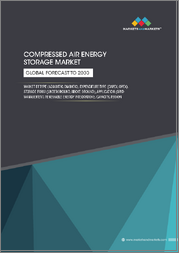
|
시장보고서
상품코드
1785622
압축 공기 에너지 저장 시장 : 시장 규모, 점유율, 성장 분석 - 유형별, 용량별, 저장 형태별, 저장 용량별, 용도별, 지역별, 산업별 예측(2025-2032년)Compressed Air Energy Storage Market Size, Share, and Growth Analysis, By Type (Diabatic, Adiabatic), By Capacity (Micro, Small), By Storage Form, By Storage Capacity, By Application, By Region - Industry Forecast 2025-2032 |
||||||
세계의 압축 공기 에너지 저장 시장 규모는 2023년에 6억 9,000만 달러로 평가되었고, 2024년 8억 2,000만 달러에서 2032년에는 31억 6,000만 달러로 성장할 전망이며, 예측 기간(2025-2032년) CAGR 18.4%로 성장할 것으로 예측됩니다.
세계의 압축 공기 에너지 저장(CAES) 부문은 몇 가지 중요한 요인들로 인해 큰 성장이 예상됩니다. 신재생 에너지원의 보급에 따라 신뢰할 수 있는 에너지 저장 솔루션에 대한 수요가 높아지고 있습니다. 또한 세계 전력 수요의 급증이 에너지 저장 기술의 혁신을 촉진하고 있습니다. 기술이 지속적으로 발전함에 따라 CAES는 수급 균형을 유지하기 위한 보다 현실적인 선택이 되고 있습니다. 또한 환경 의식이 높아짐에 따라 지속 가능한 에너지에 대한 관심이 높아지고 있습니다. 이러한 동향을 종합하면 CAES 시장은 견조한 확대 궤도를 묘사하고 있으며, 보다 깨끗하고 안정적인 에너지 시스템으로의 전환에 있어 세계적으로 중요한 역할을 하는 것으로 자리매김하고 있습니다.
목차
서문
- 조사 목적
- 조사 범위
- 정의
조사 방법
- 정보 조달
- 2차 및 1차 데이터의 방법
- 시장 규모 예측
- 시장의 전제조건 및 제한
주요 요약
- 세계 시장 전망
- 공급 및 수요 동향 분석
- 부문별 기회 분석
시장 역학 및 전망
- 시장 개요
- 시장 규모
- 시장 역학
- 성장 촉진요인 및 기회
- 성장 억제요인 및 과제
- Porter's Five Forces 분석
주요 시장 인사이트
- 중요성공요인
- 경쟁도
- 주요 투자 기회
- 시장 생태계
- 시장의 매력 지수(2024년)
- PESTEL 분석
- 거시경제지표
- 밸류체인 분석
- 가격 분석
압축 공기 에너지 저장 시장 규모 : 유형별 및 CAGR(2025-2032년)
- 시장 개요
- 비단열
- 단열
- 등온
압축 공기 에너지 저장 시장 규모 : 용량별 및 CAGR(2025-2032년)
- 시장 개요
- 마이크로
- 소
- 대
압축 공기 에너지 저장 시장 규모 : 저장 형태별 및 CAGR(2025-2032년)
- 시장 개요
- 지하
- 수중
- 지상
압축 공기 에너지 저장 시장 규모 : 저장 용량별 및 CAGR(2025-2032년)
- 시장 개요
- 최대 5시간
- 5-10시간
- 10시간 이상
압축 공기 에너지 저장 시장 규모 : 용도별 및 CAGR(2025-2032년)
- 시장 개요
- 그리드 관리
- 전원 백업
- 신재생 에너지 통합
- 오프 그리드 및 마이크로 그리드 시스템
압축 공기 에너지 저장 시장 규모 : 최종 이용 산업별 및 CAGR(2025-2032년)
- 시장 개요
- 발전소
- 분산형 에너지 시스템
- 자동차용 동력
압축 공기 에너지 저장 시장 규모 및 CAGR(2025-2032년)
- 북미
- 미국
- 캐나다
- 유럽
- 독일
- 스페인
- 프랑스
- 영국
- 이탈리아
- 기타 유럽
- 아시아태평양
- 중국
- 인도
- 일본
- 한국
- 기타 아시아태평양
- 라틴아메리카
- 브라질
- 기타 라틴아메리카
- 중동 및 아프리카
- GCC 국가
- 남아프리카
- 기타 중동 및 아프리카
경쟁 정보
- 상위 5개사 비교
- 주요 기업의 시장 포지셔닝(2024년)
- 주요 시장 기업이 채용한 전략
- 최근 시장 동향
- 기업의 시장 점유율 분석(2024년)
- 주요 기업의 기업 프로파일
- 기업의 상세
- 제품 포트폴리오 분석
- 기업의 부문별 점유율 분석
- 수익의 전년대비 비교(2022-2024년)
주요 기업 프로파일
- Hydrostor(Canada)
- Siemens Energy AG(Germany)
- Storelectric Limited(UK)
- Corre Energy(Netherlands)
- Apex Compressed Air Energy Storage, LLC(USA)
- Cheesecake Energy(UK)
- ALACAES(Switzerland)
- TerraStor(USA)
- BaroMar(Israel)
- General Compression Ltd.(GCL)(USA)
- Bright Energy Storage Technologies(USA)
- Pacific Gas and Electric Company(PG&E)(USA)
- Ridge Energy Storage and Grid Services LP(USA)
- Innovatium(UK)
- Carnot Compression, LLC(USA)
- LightSail Energy(USA)
- MAN Energy Solutions SE(Germany)
- Atlas Copco AB(Sweden)
- Ingersoll Rand Inc.(USA)
결론 및 권고
AJY 25.08.14Global Compressed Air Energy Storage Market size was valued at USD 0.69 billion in 2023 and is poised to grow from USD 0.82 billion in 2024 to USD 3.16 billion by 2032, growing at a CAGR of 18.4% during the forecast period (2025-2032).
The global Compressed Air Energy Storage (CAES) sector is poised for significant growth driven by several key factors. There is an increasing demand for dependable energy storage solutions as renewable energy sources become more prevalent. Additionally, the soaring global power requirements are prompting innovations in energy storage technologies. With continuous advancements in technology, CAES is becoming a more viable option for balancing supply and demand. Furthermore, heightened environmental awareness is steering attention toward sustainable energy practices. Collectively, these trends indicate a robust expansion trajectory for the CAES market, positioning it as a crucial player in the transition to cleaner and more reliable energy systems worldwide.
Top-down and bottom-up approaches were used to estimate and validate the size of the Global Compressed Air Energy Storage market and to estimate the size of various other dependent submarkets. The research methodology used to estimate the market size includes the following details: The key players in the market were identified through secondary research, and their market shares in the respective regions were determined through primary and secondary research. This entire procedure includes the study of the annual and financial reports of the top market players and extensive interviews for key insights from industry leaders such as CEOs, VPs, directors, and marketing executives. All percentage shares split, and breakdowns were determined using secondary sources and verified through Primary sources. All possible parameters that affect the markets covered in this research study have been accounted for, viewed in extensive detail, verified through primary research, and analyzed to get the final quantitative and qualitative data.
Global Compressed Air Energy Storage Market Segments Analysis
Global Compressed Air Energy Storage Market is segmented by Type, Capacity, Storage Form, Storage Capacity, Application, End Use Industry and region. Based on Type, the market is segmented into Diabatic, Adiabatic and Isothermal. Based on Capacity, the market is segmented into Micro, Small and Large. Based on Storage Form, the market is segmented into Underground, Underwater and Above Ground. Based on Storage Capacity, the market is segmented into Up to 5 hours, 5-10 hours and 10 hours and Above. Based on Application, the market is segmented into Grid Management, Power Backup, Renewable Energy Integration and Off-Grid and Microgrid Systems. Based on End Use Industry, the market is segmented into Power Station, Distributed Energy System and Automotive Power. Based on region, the market is segmented into North America, Europe, Asia Pacific, Latin America and Middle East & Africa.
Driver of the Global Compressed Air Energy Storage Market
The increasing worldwide adoption of intermittent renewable energy sources, such as solar and wind, significantly drives the growth of the Compressed Air Energy Storage (CAES) market. These systems offer vital long-duration storage capabilities that help stabilize electrical grids by capturing excess energy produced during peak generation periods. This stored energy can then be released when renewable sources are not generating electricity, effectively ensuring a dependable and consistent power supply. By facilitating the integration of renewable energy into the grid, CAES systems are becoming essential components in the transition towards a more sustainable energy landscape.
Restraints in the Global Compressed Air Energy Storage Market
The Global Compressed Air Energy Storage (CAES) market faces significant challenges due to high capital expenditures. Establishing the necessary infrastructure, which includes expansive subsea and on-land caverns, along with compressors and turbines, entails substantial initial investments. This financial hurdle can hinder the adoption of CAES technologies, even though they demonstrate reliability and a longer lifespan compared to other energy storage solutions. Additionally, CAES offers an effective means for large-scale, long-duration energy storage, which is crucial for facilitating the incorporation of renewable energy sources into the overall energy framework.
Market Trends of the Global Compressed Air Energy Storage Market
The Global Compressed Air Energy Storage (CAES) market is witnessing significant growth driven by the increasing adoption of intermittent renewable energy sources such as solar and wind. As the global energy landscape shifts toward sustainability, the demand for long-duration storage solutions has intensified, positioning CAES as a crucial player in ensuring grid reliability and effective demand-supply management. These systems enhance peak load management capabilities, offering a robust solution to the challenges posed by fluctuating energy outputs. Furthermore, CAES technology aligns with global decarbonization efforts, making it an essential component of the transition towards a cleaner and more resilient energy infrastructure.
Table of Contents
Introduction
- Objectives of the Study
- Scope of the Report
- Definitions
Research Methodology
- Information Procurement
- Secondary & Primary Data Methods
- Market Size Estimation
- Market Assumptions & Limitations
Executive Summary
- Global Market Outlook
- Supply & Demand Trend Analysis
- Segmental Opportunity Analysis
Market Dynamics & Outlook
- Market Overview
- Market Size
- Market Dynamics
- Drivers & Opportunities
- Restraints & Challenges
- Porters Analysis
- Competitive rivalry
- Threat of substitute
- Bargaining power of buyers
- Threat of new entrants
- Bargaining power of suppliers
Key Market Insights
- Key Success Factors
- Degree of Competition
- Top Investment Pockets
- Market Ecosystem
- Market Attractiveness Index, 2024
- PESTEL Analysis
- Macro-Economic Indicators
- Value Chain Analysis
- Pricing Analysis
Global Compressed Air Energy Storage Market Size by Type & CAGR (2025-2032)
- Market Overview
- Diabatic
- Adiabatic
- Isothermal
Global Compressed Air Energy Storage Market Size by Capacity & CAGR (2025-2032)
- Market Overview
- Micro
- Small
- Large
Global Compressed Air Energy Storage Market Size by Storage Form & CAGR (2025-2032)
- Market Overview
- Underground
- Underwater
- Above Ground
Global Compressed Air Energy Storage Market Size by Storage Capacity & CAGR (2025-2032)
- Market Overview
- Up to 5 hours
- 5-10 hours
- 10 hours and Above
Global Compressed Air Energy Storage Market Size by Application & CAGR (2025-2032)
- Market Overview
- Grid Management
- Power Backup
- Renewable Energy Integration
- Off-Grid and Microgrid Systems
Global Compressed Air Energy Storage Market Size by End Use Industry & CAGR (2025-2032)
- Market Overview
- Power Station
- Distributed Energy System
- Automotive Power
Global Compressed Air Energy Storage Market Size & CAGR (2025-2032)
- North America (Type, Capacity, Storage Form, Storage Capacity, Application, End Use Industry)
- US
- Canada
- Europe (Type, Capacity, Storage Form, Storage Capacity, Application, End Use Industry)
- Germany
- Spain
- France
- UK
- Italy
- Rest of Europe
- Asia Pacific (Type, Capacity, Storage Form, Storage Capacity, Application, End Use Industry)
- China
- India
- Japan
- South Korea
- Rest of Asia-Pacific
- Latin America (Type, Capacity, Storage Form, Storage Capacity, Application, End Use Industry)
- Brazil
- Rest of Latin America
- Middle East & Africa (Type, Capacity, Storage Form, Storage Capacity, Application, End Use Industry)
- GCC Countries
- South Africa
- Rest of Middle East & Africa
Competitive Intelligence
- Top 5 Player Comparison
- Market Positioning of Key Players, 2024
- Strategies Adopted by Key Market Players
- Recent Developments in the Market
- Company Market Share Analysis, 2024
- Company Profiles of All Key Players
- Company Details
- Product Portfolio Analysis
- Company's Segmental Share Analysis
- Revenue Y-O-Y Comparison (2022-2024)
Key Company Profiles
- Hydrostor (Canada)
- Company Overview
- Business Segment Overview
- Financial Updates
- Key Developments
- Siemens Energy AG (Germany)
- Company Overview
- Business Segment Overview
- Financial Updates
- Key Developments
- Storelectric Limited (UK)
- Company Overview
- Business Segment Overview
- Financial Updates
- Key Developments
- Corre Energy (Netherlands)
- Company Overview
- Business Segment Overview
- Financial Updates
- Key Developments
- Apex Compressed Air Energy Storage, LLC (USA)
- Company Overview
- Business Segment Overview
- Financial Updates
- Key Developments
- Cheesecake Energy (UK)
- Company Overview
- Business Segment Overview
- Financial Updates
- Key Developments
- ALACAES (Switzerland)
- Company Overview
- Business Segment Overview
- Financial Updates
- Key Developments
- TerraStor (USA)
- Company Overview
- Business Segment Overview
- Financial Updates
- Key Developments
- BaroMar (Israel)
- Company Overview
- Business Segment Overview
- Financial Updates
- Key Developments
- General Compression Ltd. (GCL) (USA)
- Company Overview
- Business Segment Overview
- Financial Updates
- Key Developments
- Bright Energy Storage Technologies (USA)
- Company Overview
- Business Segment Overview
- Financial Updates
- Key Developments
- Pacific Gas and Electric Company (PG&E) (USA)
- Company Overview
- Business Segment Overview
- Financial Updates
- Key Developments
- Ridge Energy Storage and Grid Services LP (USA)
- Company Overview
- Business Segment Overview
- Financial Updates
- Key Developments
- Innovatium (UK)
- Company Overview
- Business Segment Overview
- Financial Updates
- Key Developments
- Carnot Compression, LLC (USA)
- Company Overview
- Business Segment Overview
- Financial Updates
- Key Developments
- LightSail Energy (USA)
- Company Overview
- Business Segment Overview
- Financial Updates
- Key Developments
- MAN Energy Solutions SE (Germany)
- Company Overview
- Business Segment Overview
- Financial Updates
- Key Developments
- Atlas Copco AB (Sweden)
- Company Overview
- Business Segment Overview
- Financial Updates
- Key Developments
- Ingersoll Rand Inc. (USA)
- Company Overview
- Business Segment Overview
- Financial Updates
- Key Developments



















